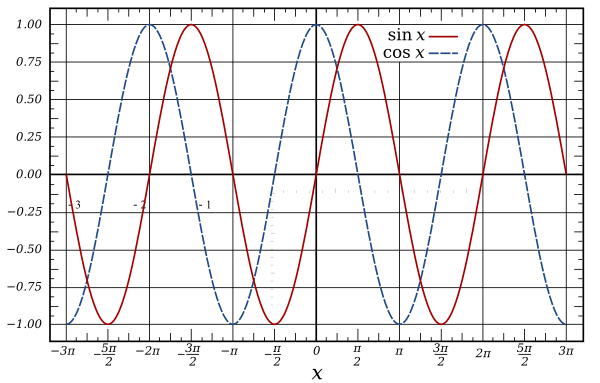使用 Math.sin 的周期函数
Math.sin 和 Math.cos 是循环的,周期为 2 * PI 弧度(360 度),它们输出幅度为 2 的波,范围为 -1 到 1。
它们对于许多类型的周期性计算都非常方便,从创建声波到动画,甚至编码和解码图像数据
此示例显示如何创建一个简单的正弦波,控制周期/频率,相位,幅度和偏移。
使用的时间单位是秒。
最简单的形式,仅控制频率。
// time is the time in seconds when you want to get a sample
// Frequency represents the number of oscillations per second
function oscillator(time, frequency){
return Math.sin(time * 2 * Math.PI * frequency);
}
几乎在所有情况下,你都希望对返回的值进行一些更改。修改的常用术语
- 相位:从振荡开始的频率偏移。它是一个 0 到 1 范围内的值,其中值 0.5 将波向前移动一半的频率。值 0 或 1 不做任何更改。
- 幅度:一个周期内距最低值和最高值的距离。幅度为 1 的范围为 2.最低点(波谷)-1 至最高(峰值)1。对于频率为 1 的波峰值为 0.25 秒,波谷为 0.75。
- 偏移:向上或向下移动整个波。
要在函数中包含所有这些:
function oscillator(time, frequency = 1, amplitude = 1, phase = 0, offset = 0){
var t = time * frequency * Math.PI * 2; // get phase at time
t += phase * Math.PI * 2; // add the phase offset
var v = Math.sin(t); // get the value at the calculated position in the cycle
v *= amplitude; // set the amplitude
v += offset; // add the offset
return v;
}
或者以更紧凑(并且更快的形式):
function oscillator(time, frequency = 1, amplitude = 1, phase = 0, offset = 0){
return Math.sin(time * frequency * Math.PI * 2 + phase * Math.PI * 2) * amplitude + offset;
}
除时间之外的所有论据都是可选的
